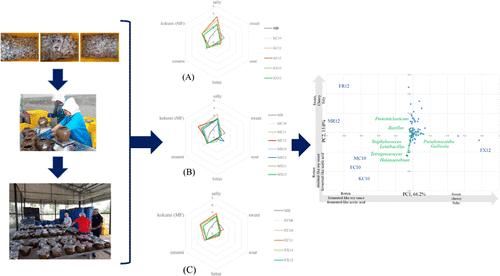当前位置:
X-MOL 学术
›
J. Agric. Food Chem.
›
论文详情
Our official English website, www.x-mol.net, welcomes your feedback! (Note: you will need to create a separate account there.)
Exploring the Relationships Between Bacterial Community, Taste-Enhancing Peptides and Aroma in Thai Fermented Fish (Pla-ra)
Journal of Agricultural and Food Chemistry ( IF 6.1 ) Pub Date : 2024-04-26 , DOI: 10.1021/acs.jafc.3c09003 Preecha Phuwapraisirisan 1 , Apiniharn Phewpan 2 , Kannapon Lopetcharat 3 , Corinna Dawid 4 , Thomas Hofmann 4 , Suwimon Keeratipibul 5
Journal of Agricultural and Food Chemistry ( IF 6.1 ) Pub Date : 2024-04-26 , DOI: 10.1021/acs.jafc.3c09003 Preecha Phuwapraisirisan 1 , Apiniharn Phewpan 2 , Kannapon Lopetcharat 3 , Corinna Dawid 4 , Thomas Hofmann 4 , Suwimon Keeratipibul 5
Affiliation

|
As a traditional Thai condiment, Pla-ra is used to add flavor and richness to dishes. Nine treatment combinations of Pla-ra formulations created from 3 types of fish (Mor fish, Kradee fish, and Mor + Kradee fish) and 4 different carbohydrate sources (none, rice bran, roasted rice, and rice bran─roasted rice mixture) were studied through a 12 month fermentation period (1, 3, 5, 7, 8, 9, 10, 11, and 12 months). 16S rRNA Next Generation Sequencing (NGS) and LC–MS/MS techniques were used to analyze the microbial diversity and identify taste-enhancing peptides. Descriptive sensory analysis was performed on the extracts of the 108 Pla-ra samples mixed in a model broth. Koku perception and saltiness-enhancing attributes were clearly perceived and dominant in all samples, even though glutamyl peptides, including γ-Glu-Val-Gly, were found at subthreshold levels. The samples from mixed fish and Mor fish fermented with roasted ground rice and rice bran for 12 months had the most typical Pla-ra odors and tastes and had high taste-enhancing activities. NGS analysis revealed the presence of bacteria containing a large number of protease and aminopeptidase genes in the samples. Bacillus spp., Gallicola spp., and Proteiniclasticum spp. correlated well with the generation of glutamyl and arginyl peptides and typical odors in the samples. These results confirmed the typical sensory quality of Pla-ra depended on protein sources, carbohydrate sources, and bacteria communities. Further optimization of the microbial composition found could lead to the development of starter cultures to control and promote flavor development in fermented fish products.
中文翻译:

探索泰国发酵鱼 (Pla-ra) 中细菌群落、增味肽和香气之间的关系
作为一种传统的泰国调味品,Pla-ra用于为菜肴增添风味和丰富性。Pla-ra配方的九种治疗组合由 3 种鱼(Mor 鱼、Kradee 鱼和 Mor + Kradee 鱼)和 4 种不同的碳水化合物来源(无、米糠、烤米和米糠─烤米混合物)制成。通过 12 个月的发酵期(1、3、5、7、8、9、10、11 和 12 个月)进行研究。使用 16S rRNA 新一代测序 (NGS) 和 LC-MS/MS 技术分析微生物多样性并鉴定增味肽。对混合在模型肉汤中的108 个Pla-ra样品的提取物进行了描述性感官分析。尽管谷氨酰肽(包括 γ-Glu-Val-Gly)的含量低于阈值水平,但在所有样品中,Koku 感知和咸味增强属性均被清晰感知并占主导地位。混合鱼和莫尔鱼与烤米米糠发酵12个月的样品具有最典型的Pla-ra气味和味道,并且具有较高的增味活性。 NGS分析显示样品中存在含有大量蛋白酶和氨肽酶基因的细菌。芽孢杆菌属、Gallicola spp. 和Proteiniclasticum spp.与谷氨酰肽和精氨酰肽的产生以及样品中的典型气味密切相关。这些结果证实了Pla-ra的典型感官质量取决于蛋白质来源、碳水化合物来源和细菌群落。对所发现的微生物组成的进一步优化可能会导致发酵剂培养物的开发,以控制和促进发酵鱼产品的风味发展。
更新日期:2024-04-26
中文翻译:

探索泰国发酵鱼 (Pla-ra) 中细菌群落、增味肽和香气之间的关系
作为一种传统的泰国调味品,Pla-ra用于为菜肴增添风味和丰富性。Pla-ra配方的九种治疗组合由 3 种鱼(Mor 鱼、Kradee 鱼和 Mor + Kradee 鱼)和 4 种不同的碳水化合物来源(无、米糠、烤米和米糠─烤米混合物)制成。通过 12 个月的发酵期(1、3、5、7、8、9、10、11 和 12 个月)进行研究。使用 16S rRNA 新一代测序 (NGS) 和 LC-MS/MS 技术分析微生物多样性并鉴定增味肽。对混合在模型肉汤中的108 个Pla-ra样品的提取物进行了描述性感官分析。尽管谷氨酰肽(包括 γ-Glu-Val-Gly)的含量低于阈值水平,但在所有样品中,Koku 感知和咸味增强属性均被清晰感知并占主导地位。混合鱼和莫尔鱼与烤米米糠发酵12个月的样品具有最典型的Pla-ra气味和味道,并且具有较高的增味活性。 NGS分析显示样品中存在含有大量蛋白酶和氨肽酶基因的细菌。芽孢杆菌属、Gallicola spp. 和Proteiniclasticum spp.与谷氨酰肽和精氨酰肽的产生以及样品中的典型气味密切相关。这些结果证实了Pla-ra的典型感官质量取决于蛋白质来源、碳水化合物来源和细菌群落。对所发现的微生物组成的进一步优化可能会导致发酵剂培养物的开发,以控制和促进发酵鱼产品的风味发展。



























 京公网安备 11010802027423号
京公网安备 11010802027423号